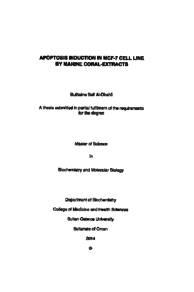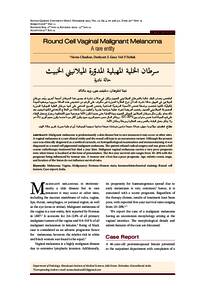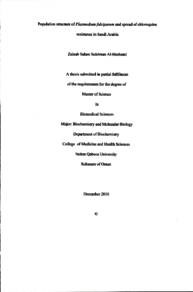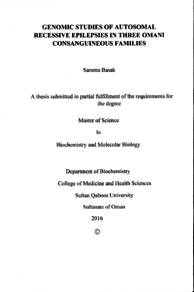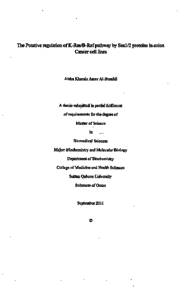Document
Apoptosis induction in MCF-7 cell line by marine corals extract
Publisher
Sultan Qaboos University
Gregorian
2014
Language
English
Subject
English abstract
Background: Marine environment is a natural reservoir for different products, some of which have been tried for the treatment of different diseases including cancer where apoptosis was induced for the killing of cancer cells. Corals have many potential secondary metabolites such as sesquiterpenoids, diterpenes and sterols that exhibit cytotoxicity on cancer cells. Thus, the major interest in testing corals against cancer cells to discover curative, effective and tumor-specific chemopreventive agents. Aim: This study aimed to screen coral extracts from two different species (Sarcophyton sp. and Acanthogorgia sp.) collected from Bandar Al-Khayran area (Muscat, Sultanate of Oman) for their cytotoxicity against breast cancer cells (MCF-7) and to explore the cellular apoptotic pathways induced by these natural products. Methods: MTT assay was performed to test the cytotoxicity and determine the IC50 - a concentration at which 50% of the cells are killed. Also, Hoechst stain was used to confirm apoptosis induction and assess the morphological change of nuclei. Moreover, qRT-PCR and western blot analyses were used to examine the expression of the genes and proteins associated with apoptosis, respectively. Results: The IC50 for Sarcophyton sp. and Acanthogorgia sp. was determined to be 97.46 (ug/ml) and 385.2 (ug/mL), respectively. Hoechst staining revealed pyknotic and fragmented nuclei compared to the untreated cell. Sarcophyton sp.- induced apoptosis involved an increase in caspase-3. Moreover, an increase in the expression of p53 proteins was observed in MCF-7 cells treated with Acanthogorgia sp. Crude extract. Conclusion: The two corals used in this study induced apoptosis in the cancer cell line MCF-7 as indicated by nuclear condensation, fragmentation and the increased expression of caspase-3 and p53 proteins. Although, the chemical properties of these two corals are not studied yet, this study clearly shows an apoptotic induction in treated cells. This present investigations could be considered as a pilot study, and purification of the extracts as well as the use of appropriate normal cells would most likely improve the effectiveness of theses natural products on cancer cells.
Member of
Resource URL
Arabic abstract
خلفية: تعتبر البيئة البحرية مستودع طبيعي لمنتجات مختلفة، والبعض منها قد تم تجريبه لعلاج مختلف الأمراض بما في ذلك السرطان وذلك عن طريق موت الخلايا المبرمج (apoptosis) لقتل الخلايا السرطانية. الشعاب المرجانية تحتوي على العديد من المركبات الثانوية مثل ,sterols diterpenes sesquiterpenoids والتي تظهر سمية خلوية على الخلايا السرطانية. بالتالي، هناك اهتمام كبير في اختبار الشعاب المرجانية ضد الخلايا السرطانية لاكتشاف عوامل علاجية وقائية فعالة وكذلك نوعية للورم السرطاني.
الهدف: هدفت هذه الدراسة إلى فحص خلاصة مرجانية من اثنين من الأنواع المختلفة (Sarcophyton sp و sp Acanthogorgia التي جمعت من منطقة بندر الخيران (مسقط، سلطنة عمان لسميتها الخلوية ضد خلايا سرطان الثدي (7-MCF) وإلى استكشاف مسارات الموت الخلوي المبرمج الناجمة عن هذه المنتجات الطبيعية.
الطرق: تم تنفيذ فحص MTT و Alamar blue لاختبار السمية الخلوية وتحديد IC50 - التركيز الذي يقتل ۵۰٪ من الخلايا . أيضا، تم استخدام صبغة Hoechst لتأكيد موت الخلايا المبرمج وتقييم التغيير الشكلي للنوى. علاوة على ذلك، استخدمت qRT - PCR و لطة ويسترن لدراسة بعض من البروتينات والجينات المرتبطة بموت الخلايا المبرمج الأساليب: إن sp Sarcophyton ) IC50 و so Acanthogorgia) تم تعيينه ى ۹۷
. 46 ( pg / mL ) و ۳۸۰ . ۲ ( g / mL على التوالي. كشفت صبغة Hoechst عن نواة تغلظية ومجزأة للخلية المعالجة مقارنة مع خلية غير معالجة. إن الموت المبرمج باستخدام خلاصة sp Sarcophyton تم عن طريق الزيادة في بروتين 3-caspase. علاوة على ذلك، لوحظ زيادة في بروتين p53 للخلايا السرطانية المعالجة بخلاصة sp Acanthogorgia .
الاستنتاج: الشعاب المرجانية المستخدمة في هذه الدراسة أحدثت موتة خلوية مبرمجة في الخلايا السرطانية 7-MCF كما يتبين ذلك من التكثيف النووي، والتجزؤ و زيادة بروتيني 3-caspase و p53. على الرغم من أن الخصائص الكيميائية لهذه الشعاب المرجانية لم تدرس بعد، لكن تظهر هذه الدراسة بوضوح موتة خلوية مبرمجة في الخلايا المعالجة. يمكن اعتبار الفحوصات الحالية كدراسة مبنية كما أن تنقية أكثر الخلاصة المرجانية واستخدام خلايا طبيعية مناسبة من الممكن أن يزيد من فعالية هذه المواد الطبيعية على الخلايا السرطانية.
الهدف: هدفت هذه الدراسة إلى فحص خلاصة مرجانية من اثنين من الأنواع المختلفة (Sarcophyton sp و sp Acanthogorgia التي جمعت من منطقة بندر الخيران (مسقط، سلطنة عمان لسميتها الخلوية ضد خلايا سرطان الثدي (7-MCF) وإلى استكشاف مسارات الموت الخلوي المبرمج الناجمة عن هذه المنتجات الطبيعية.
الطرق: تم تنفيذ فحص MTT و Alamar blue لاختبار السمية الخلوية وتحديد IC50 - التركيز الذي يقتل ۵۰٪ من الخلايا . أيضا، تم استخدام صبغة Hoechst لتأكيد موت الخلايا المبرمج وتقييم التغيير الشكلي للنوى. علاوة على ذلك، استخدمت qRT - PCR و لطة ويسترن لدراسة بعض من البروتينات والجينات المرتبطة بموت الخلايا المبرمج الأساليب: إن sp Sarcophyton ) IC50 و so Acanthogorgia) تم تعيينه ى ۹۷
. 46 ( pg / mL ) و ۳۸۰ . ۲ ( g / mL على التوالي. كشفت صبغة Hoechst عن نواة تغلظية ومجزأة للخلية المعالجة مقارنة مع خلية غير معالجة. إن الموت المبرمج باستخدام خلاصة sp Sarcophyton تم عن طريق الزيادة في بروتين 3-caspase. علاوة على ذلك، لوحظ زيادة في بروتين p53 للخلايا السرطانية المعالجة بخلاصة sp Acanthogorgia .
الاستنتاج: الشعاب المرجانية المستخدمة في هذه الدراسة أحدثت موتة خلوية مبرمجة في الخلايا السرطانية 7-MCF كما يتبين ذلك من التكثيف النووي، والتجزؤ و زيادة بروتيني 3-caspase و p53. على الرغم من أن الخصائص الكيميائية لهذه الشعاب المرجانية لم تدرس بعد، لكن تظهر هذه الدراسة بوضوح موتة خلوية مبرمجة في الخلايا المعالجة. يمكن اعتبار الفحوصات الحالية كدراسة مبنية كما أن تنقية أكثر الخلاصة المرجانية واستخدام خلايا طبيعية مناسبة من الممكن أن يزيد من فعالية هذه المواد الطبيعية على الخلايا السرطانية.
Category
Theses and Dissertations

